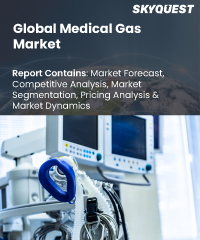
Product ID: SQSG35B2022

Report ID:
SQSG35B2022 |
Region:
Global |
Published Date: February, 2024
Pages:
165
|
Tables:
88 |
Figures:
76
Global Medical Gas Market size was valued at USD 12.8 billion in 2019 and is poised to grow from USD 13.83 billion in 2023 to USD 24.33 billion by 2031, growing at a CAGR of 8.1% in the forecast period (2024-2031).
The market is primarily driven by the increased prevalence of chronic diseases and beneficial measures launched by governmental organizations. Other factors driving the market include the growing senior population and rising demand for point-of-care and at-home healthcare goods. The need for medical gases is being driven by the increasing prevalence of Chronic Respiratory Diseases (CRDs), such as pulmonary hypertension, chronic obstructive pulmonary disease, occupational lung diseases, and asthma. For instance, according to WHO data, more than 3.0 million people worldwide pass away each year from chronic obstructive pulmonary disease (COPD), which accounts for around 6% of all fatalities and may overtake cancer as the third-leading cause of death by 2031. Additionally, according to the same report, asthma affects almost 235.0 million individuals. These respiratory diseases are treated and diagnosed using medical gases including oxygen, lung gas mixes, and heliox.
Long-term use of oxygen may lessen the pressure on the heart and help prevent pulmonary arterial hypertension. Therefore, the market is being driven ahead by the increased prevalence of respiratory illnesses. The COVID-19 epidemic had a tremendous impact on the market. Due to the pandemic's heightened demand, there were shortages of medical oxygen, which ultimately created a significant disruption in the oxygen market and supply chain breaks. For instance, according to data from Business Standard Private Ltd., the demand for liquid medicinal oxygen (LMO) in India was 700 tonnes per day before the epidemic (TPD). Demand for LMO surged by a factor of four during Covid-19's initial wave, reaching 2,800 TPD. The second wave has also resulted in a rise in demand of 5,000 TPD, or more than seven times the pre-Covid levels.
The demand for medical oxygen is increasing 5–10 times more than usual, according to a survey conducted by the European Industrial Gases Association, whose members include Air Liquide and Linde. In Italy and Eastern France, medical oxygen demand was 4-6 times higher than the average, according to Air Liquide. Therefore, the industry had a tremendous surge in growth as a result of the aforementioned variables. The rising demand from the healthcare sector is expected to be reduced over the next several years as the global COVID-19 status improves. However, it is expected that the demand for medicinal gases would continue to be stronger than it was before COVID-19.
In addition, the pandemic has sparked the creation of fresh ideas that will help the many individuals suffering from respiratory illnesses get the oxygen they need. Additionally, the industry will be driven post-COVID-19 by the growing use of home healthcare. Additionally, the market is developing as a result of an increasing number of FDA approvals for medical gas equipment. For medical oxygen gas compartments and closures, the Food and Drug Administration (FDA) is recommending updating its Current Good Manufacturing Practice (CGMP) regulations to incorporate new colour, labelling, design, and dedication standards. With the help of these standards, medical oxygen gas cylinders should be easier to identify, there will be less of a chance that industrial or other gas containers will be mistakenly connected to medical oxygen supply systems, and there will be less of a chance of medical gas pollution.
The demand for medical gases is expected to be indirectly driven by the aging, rising population who are more sensitive to chronic illnesses. Due to reduced immune systems, the elderly are more susceptible to chronic illnesses. The WHO estimates that by 2031, there may be 2.1 billion persons worldwide who are 60 years of age or older. Moreover, by 2031, there will probably be 426 million people who are 80 years of age or older. The number of elderly people has significantly increased, which has led to an increase in the prevalence of respiratory diseases. For instance, according to data from the Princeton Health Care Center, about 15.0% persons had asthma, COPD, or another respiratory illness. Such data demonstrate how the market may finally be driven during the forecast period due to the expected increase in oxygen supply demand.
Rising demand for packaged medical-grade gases is predicted to drive market growth as demand for home healthcare and point-of-care diagnostics markets increases (such as oxygen). The Food and Drug Safety and Innovation Act was put into force by a measure that the US Congress approved in July 2021. Due to the abolition of drug user fees for medical gas manufacturers and the establishment of a uniform certification procedure for medical gas, among other things, this legislation is expected to serve as a driver for this market throughout the forecast period.
US Medical Gas Market is poised to grow at a sustainable CAGR for the next forecast year.
Our industry expert will work with you to provide you with customized data in a short amount of time.
REQUEST FREE CUSTOMIZATIONGlobal Medical Gas Market size was valued at USD 12.8 billion in 2019 and is poised to grow from USD 13.83 billion in 2023 to USD 24.33 billion by 2031, growing at a CAGR of 8.1% in the forecast period (2024-2031).
Want to customize this report? This report can be personalized according to your needs. Our analysts and industry experts will work directly with you to understand your requirements and provide you with customized data in a short amount of time. We offer $1000 worth of FREE customization at the time of purchase.

Product ID: SQSG35B2022